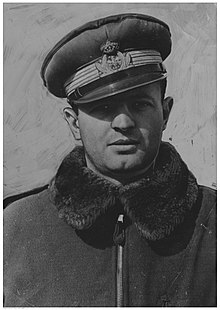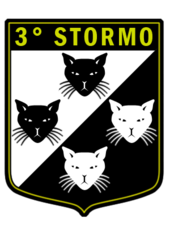Carlo Emanuele Buscaglia
Carlo Emanuele Buscaglia (born September 22, 1915 in Novara , † August 24, 1944 in Naples ) was a pilot in the Italian Air Force .
Second World War
Buscaglia was one of the few officers in the Italian Air Force who worked on the development and testing of the new torpedoes dropped from aircraft . After a brief use in a bomber squadron, he came to a new torpedo flying unit ( Reparto Speciale Aerosiluranti ), which had been set up on July 25, 1940 at the Gorizia airfield . This unit , initially charged with testing tasks , soon moved to the Libyan operational airfield El Adem. From there, they were to attack British convoys with their three-engined Savoia Marchetti SM.79 medium bombers . Despite a number of technical and logistical problems, five bombers, including Buscaglia, flew a first night raid on the British naval base in Alexandria on August 15, 1940 . The low-level flight attack failed because the torpedoes got stuck in the muddy bottom of the harbor basin. An Italian machine did not return from this mission, which was intended more as a test. On August 27, Buscaglia attacked a British cruiser alone off Sidi el Barrani , but again landed no hit.
In September 1940, the 278th torpedo squadron emerged from the test unit, which achieved its first success on September 17th. Buscaglia, together with a second SM.79, attacked a British naval unit that was firing at the Italian positions near Bardia . Both planes attacked the cruiser HMS Kent , which was badly damaged and remained out of service for 12 months. For this he was awarded the Medaglia d'oro al valor militare . This mission initiated a series of successes for the numerically quite small Italian torpedo flying force (motto: “ Pauci sed semper immites ” (German: “Few, but always effective”)). On October 14, 1940, a squadron aircraft attacked the cruiser HMS Liverpool , the bow of which was torn away by a torpedo hit. In November, Buscaglia and his comrades made several attacks on British ships, but without success. On December 3, 1940, Buscaglia succeeded in Suda ( Crete ) in an attack on the cruiser HMS Glasgow , which was also put out of action for several months. On January 10, 1941, Buscaglia operated from Catania in Sicily against a British Malta convoy.
On March 5, 1941 , Buscaglia received command of the new 281st torpedo squadron in Grottaglie near Taranto , which a short time later operated from Rhodes against British convoys in the eastern Mediterranean. After some less effective use, u. a. against the aircraft carrier HMS Formidable , succeeded on April 18, 1941, the sinking of the tanker British Science and on May 8, the damage to the freighter Rawnsley (sunk definitely on May 12). A British air raid on the Rhodes airfield forced the squadron to remain inactive for a short time. In June 1941 she again launched attacks on Cyprus and the Egyptian coast, where she sank a net-laying machine and a tanker in August.
On October 13, 1941, three SM.79s attacked a strong British naval formation west of Alexandria. For technical reasons, an SM.79 had to fly over the battleship HMS Barham , which was firing from all cylinders, at a low altitude during a torpedo attack , whereby the on-board photographer took a famous picture.
Carlo Emanuele Buscaglia's squadron flew numerous risky missions in the following months, which were not always crowned with success because of the difficult operational conditions. If this did occur, however, this almost always meant the failure or total loss of war or preferably merchant ships with their valuable supplies.
On April 1, 1942, Buscaglia took over command of the new 132nd torpedo flying group in Littoria , with the further expansion of which he was commissioned. Due to the lack of special spare parts and supplies, he often commissioned craft companies in the area with custom-made products for his aircraft. As a superior, he was valued not only for his ingenuity and his improvisational spirit, but also for his friendly and humane manner. Buscaglia was a patriot, but never made a secret of his aversion to fascism .
During the Vigorous and Harpoon operations in June 1942, Buscaglia's group operated from Sicily against the British "Harpoon" and "Vigorous" convoys and suffered considerable losses. Only a few enemy ships could be damaged. Buscaglia himself sank the freighter Chant , which had previously been damaged by German aircraft. The British destroyer HMS Bedouin was also sunk by torpedoes from Buscaglia's squadron.
During the fight against Operation Pedestal in August 1942, Buscaglia took part with his planes from Pantelleria . These sank the destroyer HMS Foresight .
After the Allied landing in northwest Africa, the 132nd group flew several missions on the Algerian coast. Due to the Allied air superiority, these increasingly assumed the character of suicide operations. Buscaglia was also shot down by fighter planes and declared missing for a short time.
After a short time in British and American captivity, he returned to Italy on June 26, 1944, to fight on the Allied side (several of his former comrades continued to fight on the German side in the north). In July he took over command of the 28th Italian bomber group. On August 23, 1944, Buscaglia had an accident while trying to take off with a Baltimore bomber near Naples . He died in hospital on August 24th at the age of 29.
Major Carlo Emanuele Buscaglia was one of the most decorated pilots of the Regia Aeronautica in World War II . In the post-war period the 3rd Squadron ( 3º Stormo, 28º and 132º Gruppo ) in Verona-Villafranca bore his name.
literature
- Martino Aichner : Il Gruppo Buscaglia - Aerosiluranti italiani nella Seconda Guerra Mondiale (Mursia Editore, 2005)
| personal data | |
|---|---|
| SURNAME | Buscaglia, Carlo Emanuele |
| BRIEF DESCRIPTION | Italian military, pilot in the Italian Air Force |
| DATE OF BIRTH | September 22, 1915 |
| PLACE OF BIRTH | Novara |
| DATE OF DEATH | August 24, 1944 |
| Place of death | Naples |

